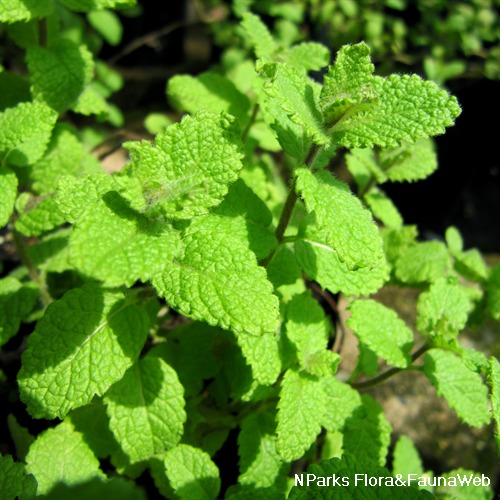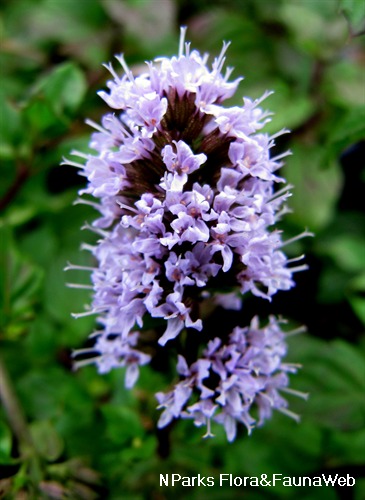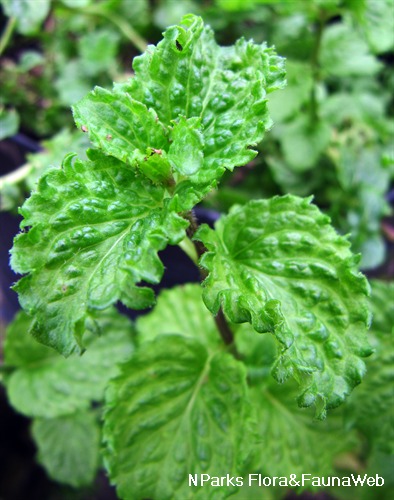
Back
Mentha suaveolens Ehrh.
| Family Name: | Lamiaceae (Labiatae) |
| Synonyms: | Mentha × rotundifolia var. suaveolens |
| Common Name: | Apple Mint, Round-Leaved Mint, Woolly Mint, 圆叶薄荷 |
Name
Classifications and Characteristics
| Plant Division | Angiosperms (Flowering Seed Plants) (Dicotyledon) |
|---|---|
| Plant Growth Form | Herbaceous Plant |
| Lifespan (in Singapore) | Perennial |
| Mode of Nutrition | Autotrophic |
| Maximum Height | 15 cm to 90 cm |
Biogeography
| Native Distribution | Southern and western Europe |
|---|---|
| Native Habitat | Terrestrial |
| Preferred Climate Zone | Temperate |
| Local Conservation Status | Non-native (Horticultural / Cultivated Only) |
Description and Ethnobotany
| Growth Form | Perennial herb with a creeping growth habit up to 0.9 m tall. |
|---|---|
| Foliage | Bright green leaves are oval with a toothed leaf margin (3-4.5 cm long, 2-4 cm wide). The venation is sunken, creating a quilted leaf texture. Leaves are densely covered by soft, white hairs. |
| Flowers | White, tubular flowers become pink or violet over time. They are arranged on a 4-9 cm tall spike inflorescence. |
| Habitat | Occurs in areas with wet soils. |
| Taxonomy | In the nursery trade, this species is often mistakenly referred to as Mentha rotundifolia. |
| Cultivation | This species is the easiest mint to grow indoors. Place it near a windowsill where it can receive at least 5-6 hours of direct sun. Regularly removing the stem's growing tip (about 2.5 cm from the tip) will help the plant to become more bushy. It is best to propagate by cuttings, because this species easily hybridizes with other mint species and taking cuttings will ensure that the parent's desired characteristics are transferred to the progeny. |
| Ethnobotanical Uses | Food (Herb or Spice): The leaves are used to make mint jellies or sauces which complement lamb dishes well. Cut - Dried Flower: The flowers and hairy leaves can be used in floral arrangements. |
Landscaping Features
| Landscape Uses | Small Gardens, Interiorscape/ Indoor Plant, Container Planting |
|---|---|
| Thematic Landscaping | Fragrant / Aromatherapy Garden, Economic Garden |
| Usage Hazard - Cons | Invasive / Potentially Invasive |
| Usage Hazard - Cons Remarks | If this species is planted outdoors, care must be taken to control its growth. Placing it in a pot before planting it in open ground will help to contain its growth. |
| Plant & Rootzone Preference or Tolerance Remarks | Soil pH of 6-7 is ideal. |
Plant Care and Propagation
| Light Preference | Full Sun, [Remarks] (Although this species will grow in semi-shade, the leaves are more flavourful when grown under full sun.) |
|---|---|
| Water Preference | Moderate Water |
| Rootzone Tolerance | Well-Drained Soils, Fertile Loamy Soils |
| Planting Remarks | This species tolerates wet soils, but its leaves will be more flavourful when grown in a well-drained potting mix. |
| Maintenance Requirements | Low |
| Propagation Method | Stem Cutting (Tip, Herbaceous) |
Foliar
| Foliage Retention | Evergreen |
|---|---|
| Mature Foliage Colour(s) | Green |
| Mature Foliage Texture(s) | Raised / Sunken Veins |
| Foliar Type | Simple / Unifoliate |
| Foliar Arrangement Along Stem | Opposite |
| Foliar Attachment to Stem | Sessile |
| Foliar Shape(s) | Non-Palm Foliage (Oval) |
| Foliar Venation | Pinnate / Net |
| Foliar Margin | Serrate / Toothed |
| Foliar Apex - Tip | Acute, Rounded |
| Foliar Base | Rounded / Obtuse |
| Typical Foliar Area | Microphyll ( 2.25cm2 - 20.25 cm2 ) |
| Typical Foliar Size | 3 cm to 4 cm |
Floral (Angiosperm)
| Flower & Plant Sexuality | Bisexual Flowers |
| Flower Colour(s) | Pink, Purple, White |
|---|---|
| Flower Grouping | Cluster / Inflorescence |
| Flower Location | Terminal |
| Individual Flower Shape | Tubular |
| Inflorescence Type | Spike |
| Flower Transitional Changes | Colour |
| Flowering Habit | Polycarpic |
| Inflorescence Size | 9 cm |
References
| References | Lawton, B.P.. 2002. Mints: A Family of Herbs and Ornamentals. USA: Timber Press. 239 pp. |
|---|
Image Repository
Others
| Master ID | 31252 |
|---|---|
| Species ID | 5647 |
| Flora Disclaimer | The information in this website has been compiled from reliable sources, such as reference works on medicinal plants. It is not a substitute for medical advice or treatment and NParks does not purport to provide any medical advice. Readers should always consult his/her physician before using or consuming a plant for medicinal purposes. |







